How to Avoid Hidden Sugars in Foods: A Smart Guide for Health-Conscious Eaters
The Sweet Trap You Didn’t See Coming!
Imagine this, you skip dessert, swap soda for water and choose healthy granola bars, yet still feel sluggish, crave sweets constantly or struggle with weight.
Sound familiar?
You’re not alone, The truth is, hidden sugars are lurking in everyday foods you’d never suspect, from whole wheat bread to salad dressing to protein bars, added sugars are sneaking into your diet, impacting your health without you even realizing it.
Understanding how to avoid hidden sugars in foods is crucial for maintaining energy, managing weight, and reducing the risk of chronic diseases. Let’s dive into how you can outsmart these sneaky additives and take control of your health.
Also read – Healthy Swaps for Your Favorite Unhealthy Foods
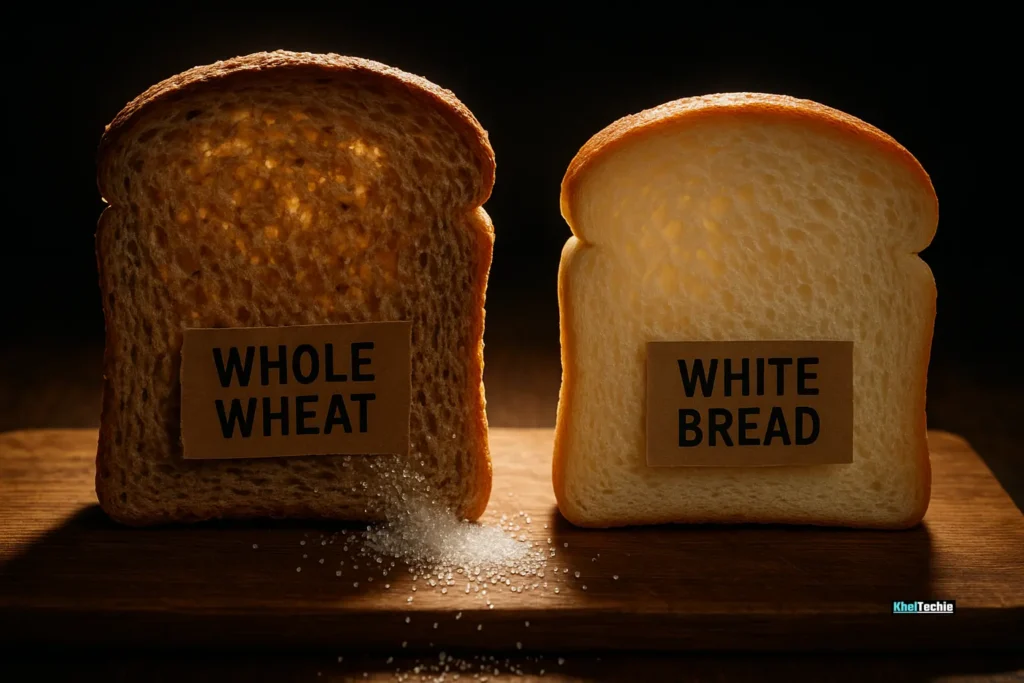
What Are Hidden Sugars?
Hidden sugars are added sugars that aren’t immediately obvious in food products. They’re often listed under different names or found in foods not typically associated with sweetness. According to the CDC, reading nutrition labels is the best way to identify added sugars in foods.
Common Aliases for Sugar
Manufacturers often use alternative names for sugar to disguise its presence. Here are some common ones:
- Sucrose
- High-fructose corn syrup
- Barley malt
- Dextrose
- Maltose
- Molasses
- Evaporated cane juice
- Agave nectar
- Fruit juice concentrates
Being aware of these terms can help you spot hidden sugars on ingredient lists and avoiding them means learning to read labels, choosing whole foods, and understanding where manufacturers hide sugar to make food more addictive.
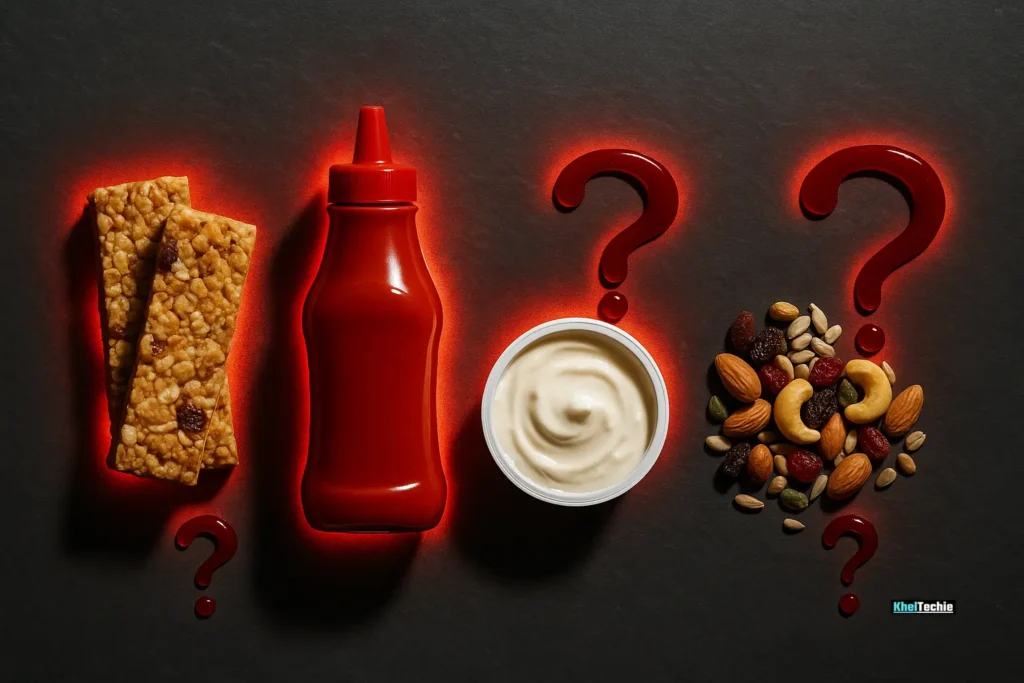
Why Avoiding Hidden Sugars Matters
Ever thought that your love for granola bars or flavored yogurts might be speeding up how fast you age?
According to a 2024 study by The American Journal of Clinical Nutrition, hidden sugars in ultra-processed foods are doing just that, accelerating your biological clock by triggering inflammation and gut issues and that’s not even the worst part.
Another recent finding shows sugar doesn’t just harm your body, it messes with your brain too. According to News.com.au, researchers found that a diet high in hidden sugars can cloud your memory, shorten your attention span, and increase the risk of cognitive decline as you age.
So, if you’re wondering why you’re always tired, forgetful, or battling random health issues despite eating healthy, it’s time to look closer at food labels. Those sneaky sugars, hiding behind fancy names like maltose or fruit juice concentrate, may be silently sabotaging your health.
Bottom line? Your body isn’t just reacting to sugar with weight gain, it’s showing signs of deeper damage. Being sugar-smart isn’t just trendy, it’s life-saving and it starts with flipping that packet over and reading what’s really inside.
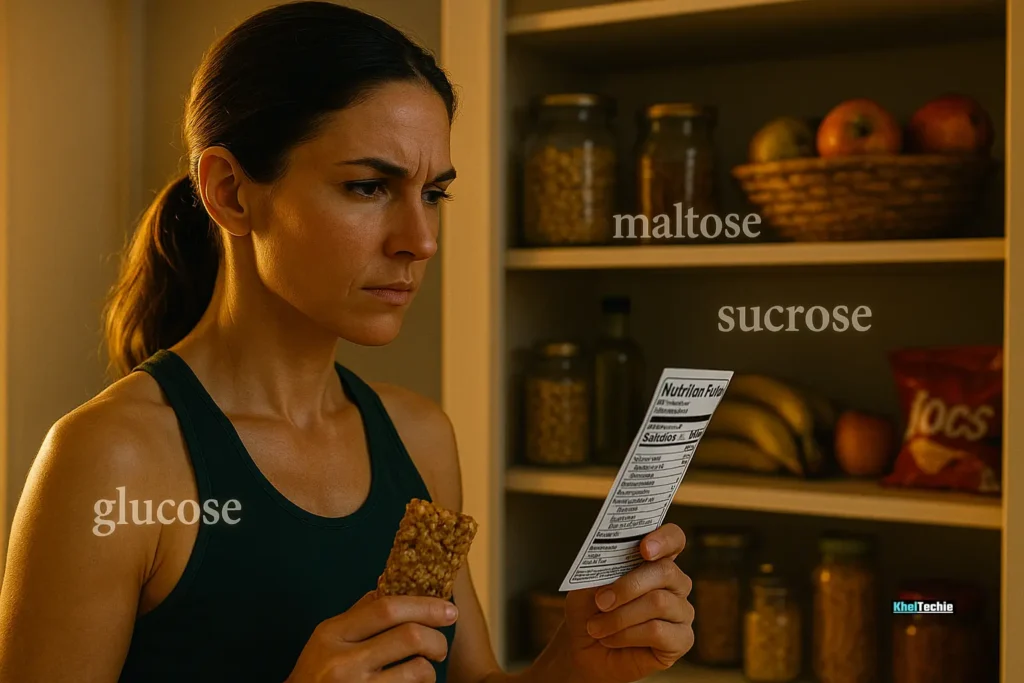
Step-by-Step: How to Avoid Hidden Sugars in Foods
Step 1: Know the Common Places Sugar Hides
Start by recognizing which foods are likely to contain added sugars, even if they seem healthy.
| Food Category | Examples with Hidden Sugar |
|---|---|
| Breakfast Foods | Flavored oatmeal, granola, cereals |
| Sauces & Dressings | Ketchup, BBQ sauce, ranch dressing |
| Yogurt | Flavored yogurts, Greek yogurt blends |
| Snacks | Granola bars, trail mix, dried fruit |
| Beverages | Smoothies, sports drinks, iced teas |
| Baked Goods | Bread, muffins, crackers |
| Frozen Meals | Pasta sauces, frozen dinners |
If you’re buying anything pre-packaged, assume there’s some form of sugar unless proven otherwise.
Step 2: Learn to Read Nutrition Labels Like a Pro
Here’s what to look for:
Check the Added Sugars Line
Since 2021, the FDA requires nutrition labels to include added sugars in grams and this is gold.
- Goal: Aim for less than 6g per serving for women, 9g for men.
- Red Flag: Anything over 12g of added sugar per serving = high-sugar zone.
Scan the Ingredients List
Look for these red flag ingredients:
- Sucrose
- Fructose
- Glucose
- Corn syrup
- Cane syrup
- Rice syrup
- Molasses
- Honey (yes, even natural ones count as added sugar when used in processed foods)
Findings – If sugar appears in the first 5 ingredients, it’s a major component of the product.
Step 3: Choose Whole Foods Over Packaged Ones
The fewer ingredients, the better. Here’s why:
- Whole foods (like fruits, veggies, legumes, nuts) naturally contain sugars but also fiber, vitamins, and minerals that slow absorption.
- Processed foods deliver sugar without the nutritional package.
Swap Ideas:
| Processed Food | Healthier Alternative |
|---|---|
| Store-bought granola bars | Homemade trail mix with nuts + unsweetened dried fruit |
| Flavored yogurt | Plain Greek yogurt + berries |
| Soda | Sparkling water + lemon/lime |
| Sweetened coffee drinks | Black coffee + cinnamon or unsweetened almond milk |
| Packaged breakfast cereals | Steel-cut oats with cinnamon and apple slices |
Step 4: Be Wary of Healthy Marketing Traps
Marketers love words like:
- Natural
- Organic
- Low-fat
- No artificial sweeteners
- Gluten-free
But none of these mean no sugar.
For example:
- Organic cookies can still be loaded with coconut sugar.
- Low-fat dressings often add sugar to compensate for flavor loss.
Always double-check the label.
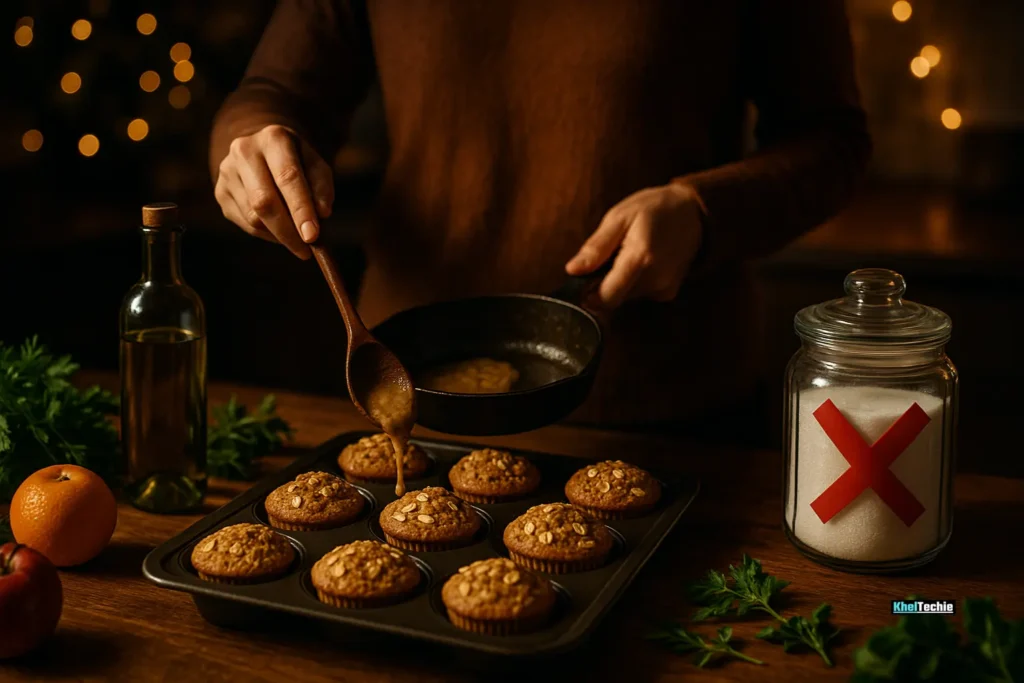
Step 5: Cook More at Home
When you cook, you control the ingredients. Try these easy swaps:
- Use herbs and spices instead of sugary sauces.
- Make your own salad dressing with olive oil, vinegar, and mustard.
- Bake your own muffins using mashed banana or applesauce instead of refined sugar.
Step 6: Stay Hydrated and Eat Balanced Meals
Sometimes sugar cravings are really thirst or hunger in disguise.
- Drink water before reaching for a snack.
- Eat balanced meals with protein, healthy fats, and fiber to stabilize blood sugar.
Instead of snacking on a sweet bar, try an apple with peanut butter.
Step 7: Track Your Intake for a Week
Use apps like MyFitnessPal or Cronometer to track your sugar intake. You might be shocked at how fast it adds up.
Set a daily goal and adjust habits accordingly.
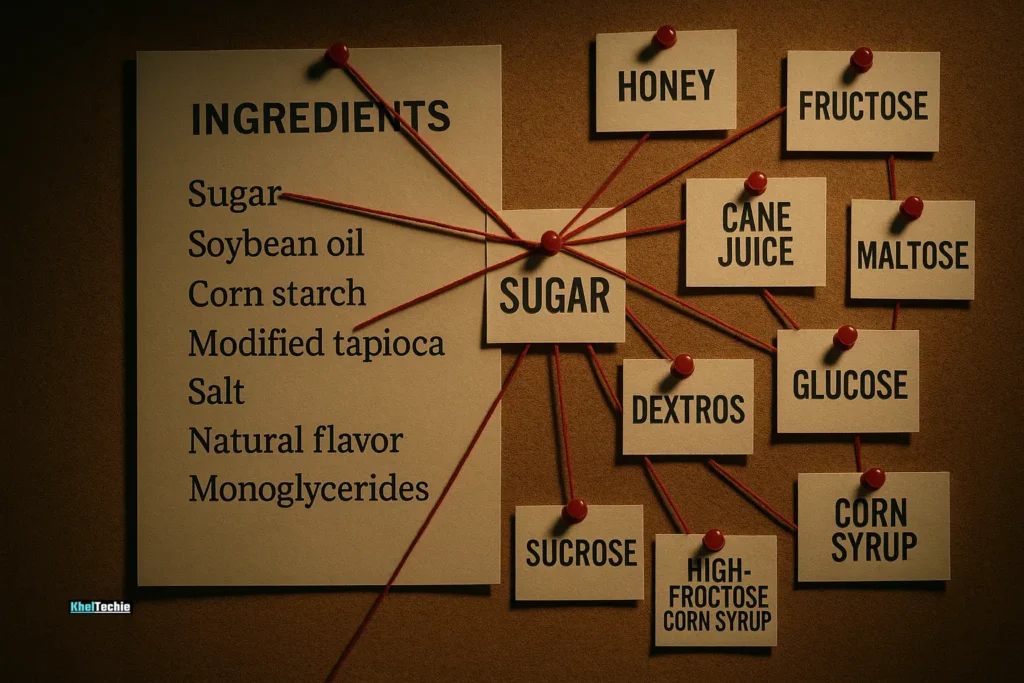
Step 8: Educate Yourself About Label Tricks
Some companies use multiple types of sugar to make it look like sugar isn’t the main ingredient.
Example: Instead of listing sugar once, they list:
- Fructose
- Maltose
- Corn syrup solids
- Brown rice syrup
This makes each appear lower on the list, but together they may be the #1 ingredient.
Lesson: Always check for sugar synonyms.
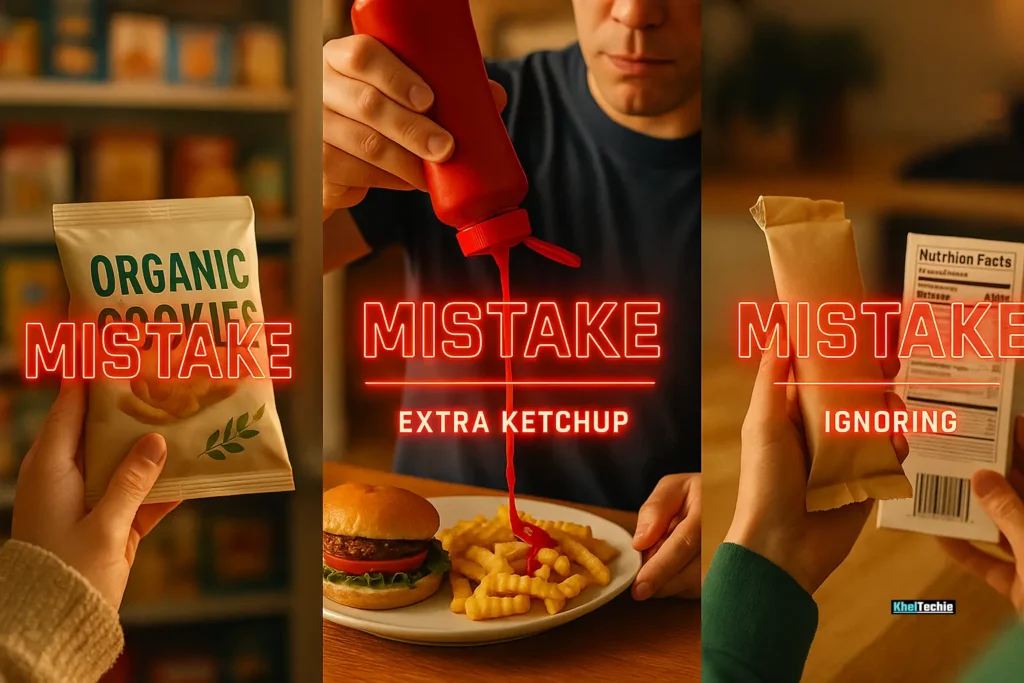
Common Mistakes People Make When Trying to Avoid Hidden Sugars
| Mistake | Why It’s a Problem | How to Fix It |
|---|---|---|
| Assuming No Added Sugar means zero sugar | Some products still contain natural sweeteners like fruit juice concentrate | Read full ingredients |
| Skipping the nutrition label entirely | Many low-fat or organic products are loaded with sugar | Always read the label |
| Relying on taste | Some sugars are subtle, especially in savory items | Don’t trust your tongue alone |
| Buying bulk snacks | Big bags encourage mindless eating | Pre-portion into small containers |
| Not checking condiments | Ketchup, BBQ sauce, and marinades are sugar bombs | Make your own or buy low-sugar versions |
Also read – Healthy Salads That Actually Taste Great
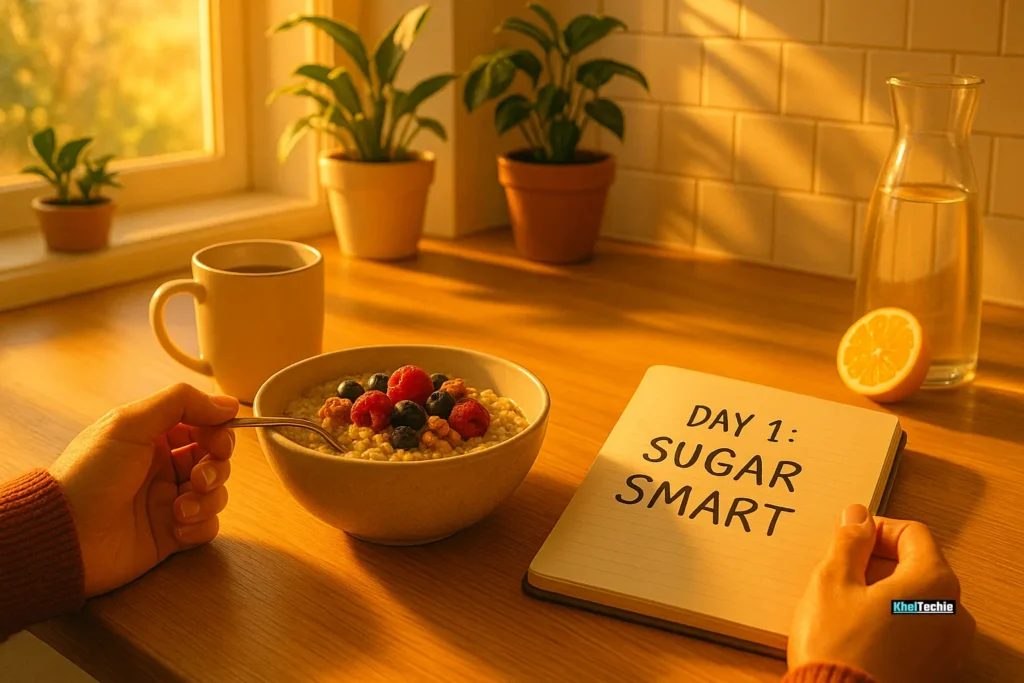
Conclusion: Start Small, Think Long-Term
Avoiding hidden sugars doesn’t mean cutting out all sweetness forever. It’s about becoming a smarter shopper, a more mindful eater, and a better advocate for your health.
Start with one change:
- Swap one sugary drink a week.
- Try making your own salad dressing.
- Read one label before buying.
Every small step counts and remember you’re not trying to be perfect, just better.
Frequently Asked Questions
Is honey a hidden sugar?
Yes, While natural honey is considered an added sugar when used in processed foods. It still affects blood sugar levels similarly to table sugar.
Do “sugar-free” products contain no sugar?
Not necessarily, They may contain sugar substitutes or sugar alcohols, which can affect blood sugar levels and digestion.
How much added sugar is recommended daily?
The American Heart Association recommends no more than 6 teaspoons (25 grams) for women and 9 teaspoons (38 grams) for men per day
Can I eat fruit if I’m avoiding hidden sugars?
Absolutely! Fruits contain natural sugars along with fiber, vitamins, and antioxidants. The fiber slows sugar absorption, making fruit a healthy choice.
How do I spot hidden sugars in bread?
Check the ingredients list for terms like dextrose, molasses, barley malt, and caramel color. These are often added to give bread a golden crust and slightly sweet flavor.
Are all packaged foods bad?
Not necessarily, Look for options with minimal ingredients and no added sugars. For example, frozen vegetables without sauce or canned beans without added flavors are fine.
Do low-fat products always have more sugar?
Often yes, Manufacturers remove fat (which adds flavor) and replace it with sugar to improve taste. Always compare regular and low-fat versions.
What are the best sugar alternatives?
Try these healthier options:
- Stevia (natural, calorie-free)
- Monk fruit extract
- Allulose (tastes like sugar, doesn’t affect blood sugar)
- Erythritol
Avoid artificial sweeteners like aspartame or sucralose unless advised by a doctor.
How do I deal with sugar cravings?
Cravings usually signal a need for balance. Try:
Drinking water
Eating a protein-rich snack
Getting enough sleep
Managing stress through meditation or walking
Is brown sugar healthier than white sugar?
No, Despite its darker color, brown sugar contains almost the same amount of calories and sugar as white sugar. The difference is minimal and mostly in flavor.
Can kids benefit from avoiding hidden sugars?
Yes! Reducing sugar improves behavior, focus, and overall health in children. Teach them to read labels early and offer fun, healthy alternatives.





Pingback: Anti-Inflammatory Diet Meal Plans: 7-Day Guide
Pingback: How To Read Food Labels For Healthy Choices: Smart Shopper
Pingback: Best Hydration Drinks For Workouts To Stay Fueled In 2025